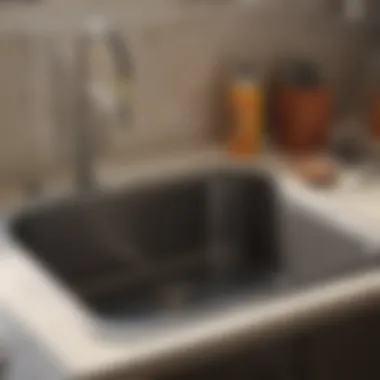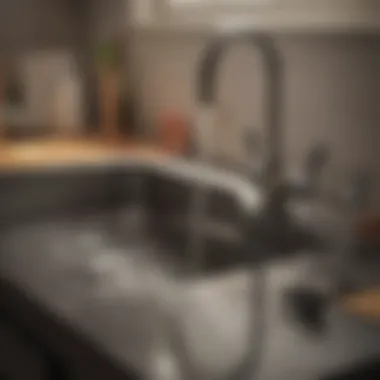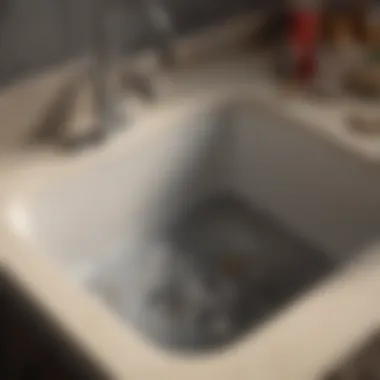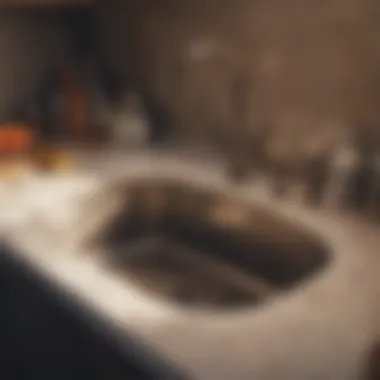Effective Methods to Remove a Garbage Disposal from Your Sink


Intro
Removing a garbage disposal from your sink can seem like a daunting task. However, with the right understanding, it can transform into a manageable project. A garbage disposal unit, found in many households, simplifies the handling of food remnants but may require removal for several reasons – perhaps it is malfunctioning, needs an upgrade, or the homeowner is remodeling their kitchen.
Overview of Topic
This segment will explore strategies for effectively dismantling a garbage disposal system. The process involves understanding the unit’s mechanics, necessary tools, and potential pitfalls homeowners may encounter.
Effective procedures in removing a garbage disposal are essential, as they ensure safety and prevent damage to surrounding plumbing structures. The significance doesn't only lie in the practical Know-how but also in empowering homeowners to tackle what is often considered a frustrating chore. As a fundamental fixture in modern kitchens, proper maintenance or removal will enhance the kitchen’s operation and longevity.
Common Challenges and Solutions
Removing a garbage disposal may lead homeowners to face persistent issues, such as tricky connections or unknown unit designs. A few common challenges encountered during this process may include:
- Leakage: Improper disconnection can lead to water leaking out. This must be handled immediately to avoid extensive water damage.
- Rust: Unit parts can be rusty, making connections harder to disassemble.
- Insufficient Tools: Not having the necessary tools handy is a frequent issue that can prolong the task.
In overcoming these obstacles, it is recommended to prepare ahead. Tackle leaking parts with towels handy to catch drips and consider rust penetrant sprays for preventing issues with corroded components. Moreover, always verify your tools before starting the project; crucial tools such as pliers, wrenches, and screwdrivers should be available on site.
Product Recommendations
While removing a garbage disposal, a host of reliable tools are beneficial. It is worthwhile to consider industry-leading brands for their products; tools like Ryobi's drill, which features excellent battery life, or Craftsman’s wrench set that exposes exquisite design and durability help to ease the removal process.
- Ryobi Drill: Powerful and manageable. Its cordless capabilities offer flexibility often needed in tight under-sink areas.
- Craftsman Wrench Set: Known for its robust construct, durable steels help handle tight fittings without damaging components.
- Klein Tools Screwdriver Set: Ergonomic and effectively designed for twist or tough screws that may resist removal.
These tools enhance efficiency and make the experience smoother—for anyone looking to engage in home renovations.
Step-by-Step Guides
The action of removing a garbage disposal can follow these methodical steps:
- Unplug the Unit: Always begin by turning off the power. Locate where the unit is plugged in and safely unplug it.
- Disconnecting Drain Lines: Remove the drain pipe from the unit, usually secured with a nut; pliers may help loosen these parts.
- Loosening Mounting Assembly: Usually located at the top, the unit is often attached by a mounting capsule held in place. Choose appropriate tools to dismantle these components carefully.
- Lower the Unit: Gently lower the disposals' unit free from its position.
- Cap Open Pipes: After removal, ensure existing opening is capped to prevent sewer gases from flooding into the kitchen.
Follow these systematic actions, and stay cautious on organization over parts, which eases re-install if needed later. Conclusively, effective removal translates to ensuring method flexibility and genuine strategy – addressing probable risks with adequate consumer products opens the door to a much safer journey allied to household improvements.
Remember that this task requires caution. Always prioritize safety measures to protect both yourself and your kitchen plumbing.
Understanding Garbage Disposal Systems
Garbage disposal systems are an essential component in many modern kitchens. They help to efficiently manage food waste by grinding it into tiny pieces, allowing it to be flushed through plumbing. Understanding how these systems work and their their benefits is crutial, especially when attempting to remove them.
Function and Importance
The primary function of a garbage disposal is to prevent food waste from cloggings sewage systems. By breaking down waste into smaller particles, disposals minimize odors and reduce the frequency of manual cleanings. Moreover, with urban living spaces tending to have smaller garbage bins, utilizing a disposal can help maintain cleanliness and hygiene in the kitchen.
In addition to functionality, having a garbage disposal can significantly improve efficiency. Users can dispose of various discarded food products such as vegetable peels, leftover soups, or scraps without filling the trash too quickly. In terms of environmental impact, it can be more sustainable compared to sending waste to landfills, although responsible use is still required.
Common Issues Leading to Removal
Despite the advantages, garbage disposals are not without their challenges. Over time, certain issues may arise that lead homeowners to consider removal rather than repair. These common problems include:
- Clogs: Overloading the disposal with fibrous or starchy foods can cause serious blockages.
- Noise: Excessively loud operations can indicate mechanical failures.
- Leaks: A persistent leaking unit can lead to sub-structural issues and water damage.
- Electrical issues: malfunctioning connections may render the garbage disposal inoperable.
Identifying these issues swiftly can help determine if removal is the best course of action when the disposal is no longer operational or creates repeated hazards in the kitchen.


Preparation Before Removal
Preparing before removing a garbage disposal is a pivotal step in the process. It ensures an organized approach which can increase safety and efficiency. Taking the time to gather your tools and clear the area makes the removal less stressful. Furthermore, it minimizes potential mishaps during the task very adavantageous step for any homeowner.
Gathering Necessary Tools
Before diving into the removal, gathering the right tools is essential. Each tool plays a specific role. Having all necessary equipment on hand creates a a more seamless workflow. Below we look closely at key tools needed.
Wrenches
The wrench is a crucial tool in the removal process. Its primary function is to loosen and tighten nuts. A well-known type is the adjustable wrench. The great thing about an adjustable wrench is that it can fit various sizes of nuts and bolts making it quite versatile. The primary advantage of using a wrench is its effectiveness. It stands out because it provides the necessary grip to unscrew connections tightly fastened.
However, misuse can lead to slipping and cause damage. Therefore, familiarity with the tool is indispensable for a successful removal.
Screwdrivers
Screwdrivers play an equally important role. Typically, you will need a flathead and a Phillips screwdriver. A flathead screwdriver works well with simple screws. It is beneficial this tool has a flat end allowing easy handling. On the other hand, Phillips screwdrivers have a cross-shaped end. This feature improves the grip with screws corresponding to this shape. Thus, choosing the correct screwdriver type is crucial as improper selection will complicate disassembly.
Another point to consider is the length of the screwdriver. Longer screws may require specifically designed screwdrivers, that reach into confined spaces more easily.
Buckets
Buckets might not be immediately associated with tools for garbage disposal removal, yet they serve an important purpose of collecting dripped fluids. A sturdy bucket helps prevent mess and cleanup time after the disposal removal process is done. The depth of the bucket rather assures that even in case of unexpected leaks, collected water won't overflow easily. Thus, carrying one with you shows forethought.
Advantages of this tool include its utility as a receptacle for waste during the leaking phase and it simplifies the cleanup later. Do to its simple structure, there aren’t many disadvantages apart from storing it which can take significant space if kept regularly.
Turning Off Power and Water Supply
Before removing your garbage disposal, it’s equally crucial to turn off power and water supply. Neglecting this step is a severe hazard. In fact, it's the primary reason why procedures sometimes lead to accidents. Switch off the circuit, locating the adequate breaker specific to your garbage disposal unit.
Doing so not only protects against electrical shocks, it also prevents any water from backup in the aconnected supply line during your repairs. Not taking sufficient safety by unplugging and turning off water secures you and ensures a much more quality experience to rely on.
Remember, safety is paramount when dealing with electrical appliances and plumbing. Always proceed with caution.
Step-by-Step Removal Process
The step-by-step removal process is pivotal in ensuring a smooth and effective experience when detaching a garbage disposal from your sink. This section emphasizes the necessity of methodical procedures, which not only simplify the task but help you avoid unnecessary complications down the line. The ability to break down each task into clearly defined sections is especially valuable for beginners. By diving into each detail, you uncover insights that enable both efficiency and safety. Having a structured approach diminishes the risks inherent in electrical disconnects and heavy lifting associated with such appliances.
Disconnection of Electrical Wiring
Disengaging the electrical wiring from a garbage disposal is a crucial first step in the removal process. This step ensures your safety before any heavy lifting begins. You must first locate the power supply and turn off the circuit to which the disposal is connected. This may involve identifying the correct breaker in your home's electrical panel.
Before removing any wiring, take the time to methodically document or note how the previous connections are configured. Tools required for this include wire cutters and a screwdriver. It’s best to wear rubber gloves to avoid electric charges. When handling electrical wiring:
- Ensure no power is flowing.
- Disconnect any grounding wires first.
- Remove the device connections securely.
Always maintain a cautious approach. If there is discomfort working with electricity, consulting a professional can save you time and potential hazards.
Draining the Disposal Unit
Draining the disposal unit is vital to eliminating any leftover waste material that may complicate the removal process. Adequately emptying the unit reduces spills, unpleasant odors, and messy accidents, embodying a clean workaround.
To drain effectively:


- Place a bucket beneath the unit to collect wastewater.
- Confirm the disposal is off and identify the plug or remove the cap if needed.
- Activate the garbage disposal mechanism briefly to clear any trapped water_rumailles.
- Tip: You can utilize a wet-dry vacuum for retention of finer debris left behind.
Take your time during this stage. Ensuring the unit is correctly drained makes it simpler to manage while detachments start.
Dismantling the Unit from the Sink
Now comes the dismantling phase, where you will physically detach the garbage disposal from the sink. This requires applying strength and precision.
First, check and loosen any mounting bolts or screws that affix the disposal to the sink assembly. Using a wrench may give you good leverage to help with tight spots. Next, you engage the disposal unit’s tab-lock mechanism if applicable.
When slowly lowering the disposal from the sink:
- Maintain a steady grip.
- Be conscious of any plumbing fixtures nearby.
- Aim to lower it directly into your bucket or designated area to manage weight and diminish risk of dropping.
After got it out, inspect surrounding areas for any lingering sections of the installation that may need removing as well.
Completing this step marks a significant achievement in the removal process. Patience and attention to detail will make the next steps easier. Navigating this stage effectively sets you up for a future successful reinstallation of a new unit if needed.
Potential Challenges During Removal
When planning to remove a garbage disposal, it's important to recognize potential challenges that might arise during the process. Understanding these potential issues helps in preparing effectively and avoiding unnecessary frustrations.
Stubborn Connections
A common challenge you may encounter is stubborn connections. These involve various parts that can become tightly bonded over time due to factors like rust or sediment accumulation. The electrical connection, waste lines, or mounting assembly can all present difficulties in this regard.
- Disconnecting the Mounting Assembly: The mounting assembly secures the disposal to the sink. Often, this connection can be tough to loosen. It's wise to use penetrating oil on the bolts or screws, letting it sit for a few minutes before attempting to remove them.
- Tackling Waste Lines: If the waste lines were sealed tightly, you might face additional resistance. Using a wrench may be helpful here. However, caution is necessary to avoid damaging the piping.
- Electrical Connectors: Sometimes, electrical connectors can snag or get stuck. Make sure to carefully inspect and see if there is a release mechanism that requires attention.
By being aware of these stubborn connections and equpping yourself with the right tools and patience, you can tackle these removal obstacles more effectively.
Unexpected Leaks
Another challenge to keep in mind is unexpected leaks that may crop up during the removal process.
- Location of Leaks: When removing the garbage disposal, water lines may detach unexpectedly, leading to leaks. It's best to have buckets ready to catch drips. This can minimize cleanup and damage to surrounding areas.
- Monitor Your Surroundings: After the disposal unit is detached, inspect the plumbing beneath the sink for any leaks. Old seals or gaskets might fail when the unit is removed, leading to water escaping.
- Ready with Tools: Having plumber's tape or sealant on hand is a smart move. In case leaks are detected, you have immediate options for repairs.
Being aware of potential leaks will not only make removal smoother but also help preserve your plumbing integrity during the process.
Although these challenges can arise, thorough preparation and patient execution can lead to a successful garbage disposal removal.
Post-Removal Considerations
After managing to remove the garbage disposal, certain considerations warrant attention. This stage can be critical in ensuring the next steps are clear and the area is prepared for any eventual installation of a new unit. Failing to address these aspects could lead to complications down the road.
Cleaning the Area
Once the disposal is removed, cleanliness should be the top priority. Debris and residue can accumulate in the under-sink area even with a well-maintained system. It’s a good idea to thoroughly clean not just the surface but all adjacent components.
- Start by removing any loose debris or waste that might have accumulated during the removal process.
- A damp cloth or sponge can be useful, especially for stubborn remnants that cling to surfaces.
- Consider using an eco-friendly cleaner for any grease or built-up stains.
This not only improves the aesthetic but also minimizes the risk of biological growth, which can occur in damp, hidden environments. Keeping the area clean ensures optimal hygiene and prepares the space for either the reinstallation of the disposal or another plumbing setup.
Inspecting for Damage


While the disposal is out, use this opportunity to inspect for any potential damage. It might be easy to overlook small cracks, leaks, or signs of wear when the unit is connected, but those issues can manifest over time.
Begin with a visual inspection of the sink and pipes. Take note of any:
- Loose connections that may need tightening.
- Visible corrosion along the pipes or fittings.
- Any leaks that might have been masked by the presence of the disposal.
Next, closely examine the mounting assembly to ensure it's not compromised. Then, check the disposal outlet and plumbing without the unit blocking visibility. By taking the time for this careful inspection, house owners can preemptively tackle problems, saving time and costs later on.
Regular checks on plumbing integrity can enhance a household's longevity and prevent unexpected outages.
Addressing these post-removal aspects will save future headaches and ensure the area is ready for any next steps. This thoughtful approach underlines the importance of respecting the intricacies of home maintenance.
Assessing Replacement Options
When it comes to removing a garbage disposal, the process does not simply end there. It is critical to assess your options for a replacement unit. Choosing a suitable garbage disposal can seal the fate of your kitchen's efficiency, performance, and cleanliness. An informed decision significantly influences your long-term satisfaction, operational costs, and overall ease of use.
Choosing a New Disposal Unit
Selecting a new garbage disposal unit involves several factors. First and foremost, consider the horsepower needed. Most household disposals come in varying power ratings, typically between 1/3 to 1 horsepower. A stronger motor is beneficial if you regularly grind fibrous vegetables or bones. However, for lighter use, a simpler model may suffice.
Next, think about the grinding technology. Some disposals utilize continuous feed systems, while others employ batch feed systems. Continuous feed allows you to add food waste while it's running, aiding in convenience. Conversely, batch feed units require a lid to be in place before they operate, which can help ensure safety but add an extra step.
Maintenance must also play a role in your decision. Stainless steel components are ideal, as they resist rusting and maintain longevity. Also, some brands offer anti-jamming features and quieter operation, which enhances user experience.
Additionally, check the warranty offered by different manufacturers. A longer warranty can protect your investment. It's also wise to research the reputation of brands like InSinkErator, Waste King, and Moen, reviewing consumer feedback for specific models.
Professional Installation Vs.
DIY
After selecting a new disposal unit, you will face another fundamental decision: should you install it yourself or hire a professional? Each option has its own merits and downfalls.
Choosing to engage in DIY installation requires a clear understanding of plumbing knowledge. If you have experience handling tools and existing household systems, this approach can save you money. You can find instructional videos and manuals that outline step-by-step processes synchronized with your specific model. However, this exposes you to certain risks. Mistakes occurring during installation could lead to leaks or deteriorating components in the future, yielding further repairs.
Contracting a professional for the installation can guarantee that the job is done efficiently. Professional plumbers often complete the work swiftly, with little risk of error, and may also identify potential compatibility issues between your plumbing framework and the new disposal. Be prepared, however, as professional services may come at higher expense. The assurance of expert skill might outweigh the cost, giving you peace of mind, especially when dealing with plumbing systems.
Consideration factor: It can be worthwhile to compare the costs of DIY material against professional installation rates, especially related to warranty coverage related issues.
Ultimately, evaluating these options carefully will enable you to make an informed choice. Proper attention to the selection and installation processes not only enhances your kitchen's functionality but can also make meal prep significantly simpler in everyday life.
Culmination
The effective removal of a garbage disposal plays a significant role in maintaining a functional kitchen environment. By following the steps outlined in this guide, house owners can confidently navigate the process, ensuring both safety and efficiency. The conclusion emphasizes several key points that contribute not only to the removal process but also to the overall experience of managing this appliance.
Summary of the Process
The removal process begins with proper preparation. First, gathering necessary tools, such as wrenches, screwdrivers, and buckets, prepares you for swift action. The next step is turning off both the power and water supply to avoid any hazards during the dismantling. After these initial steps, you proceed with the actual removal, which includes disconnecting the electrical wiring, draining the disposal unit, and finally dismantling the disposal from the sink. Adjusting your approach based on potential challenges, like stubborn connections or unexpected leaks, will further streamline your effort.
-> This systematic approach ensures that the removal is comprehensive, reducing the likelihood of complications.
Having clarity in your process helps in emphasizing the importance of precise action. Know each step to avoid uncertainties that can arise from unpreparedness.
Final Thoughts on Maintenance
Once the garbage disposal is removed, it is prudent to consider maintenance of the new unit or the overall plumbing system. Regular checks and maintenance ensure that your newly installed disposal remains in optimal working condition. Invest time in understanding how the new unit functions and what long-term maintenance it requires.
You should also inspect and clean area around the disposal regularly. Recognizing potential issues beforehand reduces the chances of needing another removal. Proper knowledge of maintenance practices extends beyond just your disposal unit; it contributes to the longevity of your kitchen setup.
By incorporating careful planning and responsibility, you take full control of your kitchen appliances, leading to a more efficient and enjoyable home environment.







